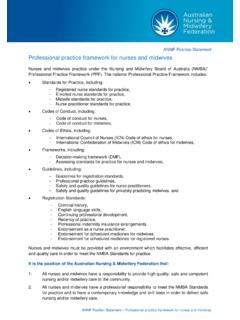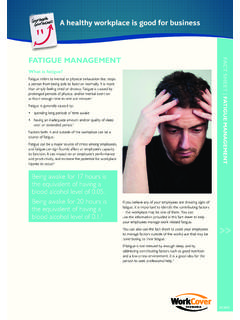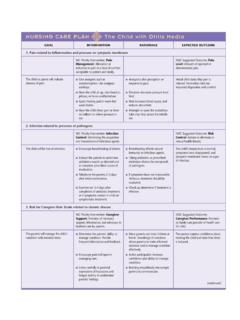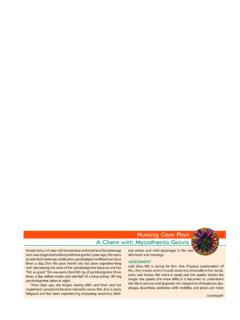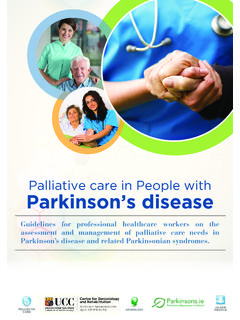Transcription of ANMF Policy Fatigue prevention - anf.org.au
1 ANMF Policy ANMF Policy Fatigue prevention Fatigue prevention The Australian Nursing and Midwifery Federation (ANMF) recognises that many nurses, midwives and assistants in nursing* in health and aged care experience Fatigue . Safe Work Australia defines Fatigue as: a state of mental and/or physical exhaustion which reduces a person s ability to perform work safely and effectively. 1 Fatigue is a serious Work Health and Safety (WHS) issue for nurses, midwives and assistants in nursing. Fatigue reduces alertness which may lead to errors and an increase in incidents and injuries.
2 Longer term health effects of Fatigue can include: Heart disease Diabetes High blood pressure Gastrointestinal disorders Lower fertility Anxiety Depression Nurses, midwives and assistants in nursing experiencing the effects of Fatigue may also expose the people in their care to increased risks of harm. The ANMF objective is to support prevention of work-related Fatigue amongst nurses, midwives and assistants in nursing. It is the Policy of the Australian Nursing and Midwifery Federation that: 1.
3 Nurses, midwives and assistants in nursing have a right to a safe and healthy workplace environment and to perform their work free from Fatigue -related health and safety risks. 2. Work-related Fatigue factors to be addressed include: Roster patterns Shift rotation and working night duty shifts in an unsafe pattern Length of shifts and length of time worked including double shifts Job demands Workload including staffing levels and skills mix Work scheduling and planning Meal and rest breaks Timing of shifts Recovery time between shifts Long periods of time awake Mentally and/or physically demanding work Environmental conditions Work-related travel including patient escorts and community visits On-call and recall
4 Requirements and arrangements Lack of management and staff awareness of the need to assess and manage Fatigue issues. *The term assistant in nursing also refers to care workers (however titled) ANMF Policy ANMF Policy Fatigue prevention 3. Factors outside of work time include: Sleep quality and length of sleep Sleep loss Disruption of the internal body clock Social life Worker s lifestyle Family needs Other employment Travel time between work and home Health conditions and medication 4. The factors outlined in 2 and 3 above may be interrelated.
5 5. The ANMF expects that employers of nurses, midwives and assistants in nursing meet their obligations under WHS legislation to, so far as is reasonably practicable, provide and maintain a working environment that is safe and without risks to health from Fatigue , by providing the following: a) Systems of work that are, so far as is reasonably practicable, safe and without risks to health from Fatigue b) Information, instruction, training and supervision to enable nurses, midwives and assistants in nursing to perform their work in a way that is safe and without risks to health from Fatigue c) A safe and comfortable work environment, for example, thermal conditions.
6 6. The ANMF expects that employers will prevent Fatigue through: a) Development and implementation of a management Policy to prevent Fatigue b) Implementation of risk management strategies to identify, assess and control Fatigue hazards and risks c) Integration of Fatigue prevention into all aspects of the workplace and systems, including workplace planning, WHS representation, consultation and issue resolution d) Communication to raise awareness, and active involvement in Fatigue prevention e) Action plans which outline management responsibilities, timelines and resource allocation for Fatigue prevention at workplace and organisation levels f) Provision of knowledge and skills in Fatigue prevention for managers and supervisors g) Provision of flexibility within working arrangements to ensure the retention of the workforce, including older workers, parents returning to work following parental leave, workers with caring responsibilities, and injured workers h)
7 Considering Fatigue when investigating incidents and work-related journey incidents including travel home after work. ANMF Policy ANMF Policy Fatigue prevention 7. The ANMF supports a risk management approach, including management responsibility for Fatigue , which involves: Identifying workplace factors that contribute to Fatigue including: a) Mental and physical demands of work, such as job demands, concentrating on tasks for extended periods of time, excessive workload, inappropriate skills mix b) Work scheduling and planning, such as long work hours, inadequate time to recover from work between shifts or erratic roster patterns, and inability to take breaks c) Inadequate staffing numbers resulting in excessive overtime, work intensification and on-call work d) Working at night, when individuals are biologically programmed to sleep e)
8 Working in uncomfortable environmental conditions f) Interaction with other hazards, such as the cumulative effects of muscle Fatigue , strains and sprains g) Work-related travel h) Factors outside of work, such as caring responsibilities i) Psychosocial hazards, including workplace violence, bullying and harassment. Assessing Fatigue risks and prioritising the hazard factors in consultation with employees and Health and Safety Representatives (HSRs). Implementing risk control measures which eliminate or minimise Fatigue risks.
9 Risk control measures should address risks associated with: a) Work scheduling and planning, such as ensuring adequate nursing and midwifery staffing and roster patterns b) Working time, such as allowing for adequate recovery time between shifts c) Mental and physical demands of work, such as eliminating excessive mental and physical demands d) Environmental conditions, such as ensuring that the workplace and surroundings are well lit, safe and secure, and of comfortable temperature e) Ongoing information and training in Fatigue assessment, procedures for reporting Fatigue , and control strategies f) Factors outside of work, such as providing training and information on recognising and avoiding Fatigue .
10 8. The ANMF supports the prevention of Fatigue through our work health and safety (WHS) and industrial activities, including through provisions in enterprise agreements on work hours, breaks, overtime, on-call, staffing levels, workload and skill mix. ANMF Policy ANMF Policy Fatigue prevention 9. The ANMF considers that prevention of Fatigue must involve consultation between employers, HSRs and affected employees. Consultation must occur when: a) Identifying where Fatigue is a workplace hazard b) Planning and designing work schedules and rosters c) Assessing Fatigue risks d) Deciding how Fatigue is to be controlled e) Changes are proposed to working hours, work schedules and working procedures f) Developing each step of the risk management approach g) Making decisions about providing information and training on Fatigue h) An incident occurs, where Fatigue may be a contributing factor i)




